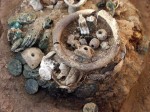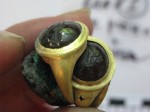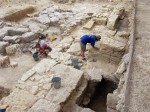 A team of Russo-Ukrainian archaeologists have unearthed two buried hoards in the citadel of Artezian, an ancient town in the Crimean Peninsula of southeastern Ukraine on the coast of the Black Sea. The hoards contain 244 copper coins from the second half of the 1st century B.C., 10 silver denarii from the reigns of Roman emperors Augustus and Tiberius, glass vessels and jewelry made out of gold, silver, bronze and gemstones. The discovery was made during the dig season of 2009 but is being published in this month’s Ancient Civilizations from Scythia to Siberia (article not available online yet).
A team of Russo-Ukrainian archaeologists have unearthed two buried hoards in the citadel of Artezian, an ancient town in the Crimean Peninsula of southeastern Ukraine on the coast of the Black Sea. The hoards contain 244 copper coins from the second half of the 1st century B.C., 10 silver denarii from the reigns of Roman emperors Augustus and Tiberius, glass vessels and jewelry made out of gold, silver, bronze and gemstones. The discovery was made during the dig season of 2009 but is being published in this month’s Ancient Civilizations from Scythia to Siberia (article not available online yet).
 Archaeologists and a constantly refreshed team of volunteers have been excavating Artezian for more than 20 years and it has yet to disappoint. There is evidence of settlement going back to the Neolithic, but it was with the dawn of the Bosporan kingdom in the 5th century B.C. that the town became a military and economic center. Its location on the Black Sea on the Kerch Straight connecting the Black Sea to the Sea of Azov and its high elevation surrounded by a forbidding terrain made it easy to defend.
Archaeologists and a constantly refreshed team of volunteers have been excavating Artezian for more than 20 years and it has yet to disappoint. There is evidence of settlement going back to the Neolithic, but it was with the dawn of the Bosporan kingdom in the 5th century B.C. that the town became a military and economic center. Its location on the Black Sea on the Kerch Straight connecting the Black Sea to the Sea of Azov and its high elevation surrounded by a forbidding terrain made it easy to defend.
 The hoards were found underneath a burnt layer which was left when the settlement was almost completely destroyed by fire during the war between the Bosporan kingdom and the Roman Empire in 44-45 A.D.
The hoards were found underneath a burnt layer which was left when the settlement was almost completely destroyed by fire during the war between the Bosporan kingdom and the Roman Empire in 44-45 A.D.
Bosporus and Rome had a long history of clientage and warfare by the first century A.D. The Spartocid dynasty that had ruled Bosporus since 438 B.C. ended in 110 B.C. The last Spartocid king left Bosporus to King Mithridates VI of Pontus, one of the greatest thorns in Rome’s side who fought against some of its greatest military leaders including Sulla and Pompey. It was Pompey who defeated him in 63 B.C., after which Mithridates fled to Bosporus where his sons ruled in his name. When his eldest son refused to help him raise yet another army to fight Rome, Mithridates had him killed. His youngest son Pharnaces then rebelled against his father. Mithridates the Great holed himself up in a citadel right next to Artezian and committed suicide.
After his father’s death, Pharnaces II begged Pompey to let him keep his kingdom and Pompey allowed it. Pharnaces had something of his father in him, though, so when he saw a chance to snatch some of Rome’s territory during Julius Caesar’s Civil War (that crossing of the Rubicon had a wide-ranging consequences) in 49 B.C., he took it. He invaded Pontus, and at first it seemed to go well. In 48 B.C. he defeated Caesar’s general Gnaeus Domitius Calvinus at the battle of Nicopolis. Then Caesar himself intervened and decisively defeated Pharnaces at Zela in 47 B.C., after which his son-in-law Asander killed him and claimed the throne. Caesar got Pharnaces’s brother Mithridates to make a counterclaim on the throne and fight his nephew for it. Mithridates won and Asander was exiled but this victory was short-lived. After Caesar’s assassination in 44 B.C., Octavian restored Asander as king.
Asander ruled until he was 93 years old and even then he had to starve himself to death to shuffle off the mortal coil. After some back and forth with Roman-backed usurpers, Asander’s son Aspurgus took the throne. Under Aspurgus’ rule starting in 8 B.C., Bosporus was a full client state of Rome. Aspurgus became a Roman citizen and added “Tiberius Julius” to his name after his patrons Augustus and Tiberius. His son Tiberius Julius Mithridates Philogermanicus Philopatris, a descendant of Mark Antony’s on his mother’s side, succeeded him in 38 A.D.
For reasons not entirely clear today, the emperor Claudius, who had supported Mithridates kingship after the death of his father, replaced him with his younger brother Tiberius Julius Cotys I in 45 A.D.. Claudius also recalled one of the Bosporan garrisons. Mithridates raised an army to fight his brother and the remaining Roman garrison, a war he promptly lost. Cotys I and Rome beat him like a drum.
All this chaos made for a dangerous living situation even in hilltop fortresses like Artezian. The Bosporan-Roman war layer is four feet below the surface and it’s packed full of artifacts from the most valuable — coins, jewelry — to the most quotidian — domestic tools — to the remains of weapons used to defend the citadel.
“The fortress had been besieged. Wealthy people from the settlement and the neighborhood had tried to hide there from the Romans. They had buried their hoards inside the citadel,” Nikolaï Vinokurov, a professor at Moscow State Pedagogical University, explained. […]
People huddled in the fortress for protection as the Romans attacked, but Vinokurov said they knew they were doomed. “We can say that these hoards were funeral sacrifices. It was obvious for the people that they were going to die shortly,” he wrote in an email to LiveScience. The siege and fall of the fortress occurred in AD 45.
Curiously, each hoard included exactly 55 coins minted by Mithridates VIII. “This is possibly just a simple coincidence, or perhaps these were equal sums received by the owners of these caskets from the supporters of Mithridates,” the team wrote in its paper.
I’m not sure why Vinokurov is so certain the citadel’s inhabitants knew they were doomed to die. Cotys could have spared the town from total annihilation, it seems to me, even if they had sided with his brother. Claudius spared Mithridates, after all.
Nice Blog, I enjoyed reading this.
Nice to see some early Julio Claudian silver denarii found. Thanks for posting.
Joe Geranio
JCIA